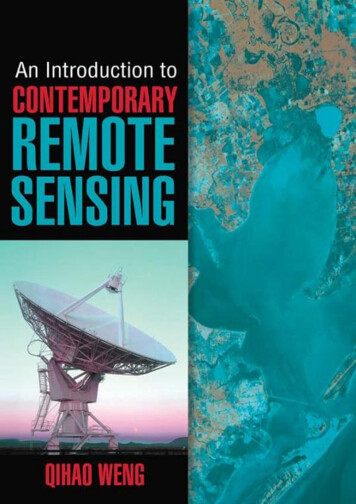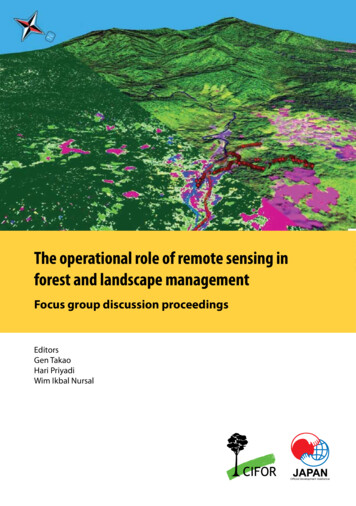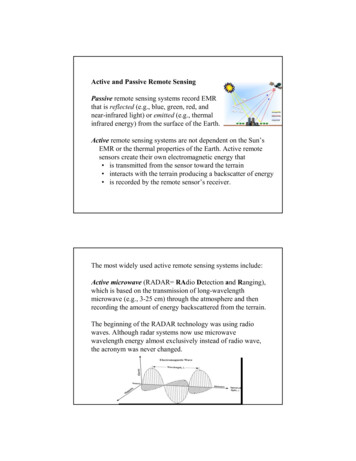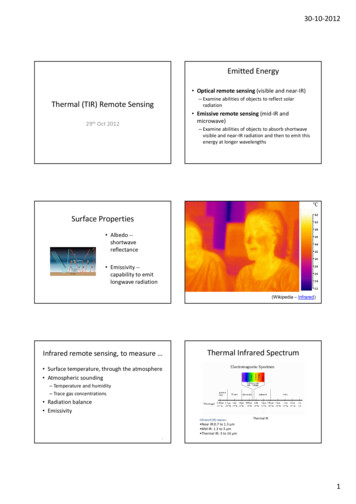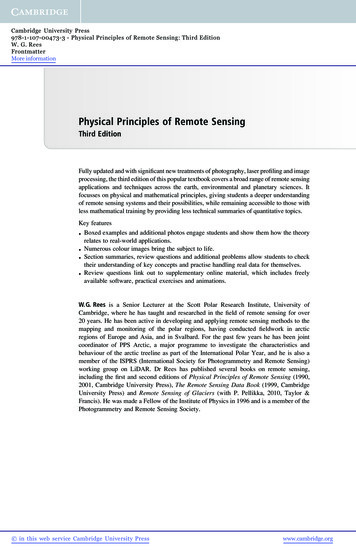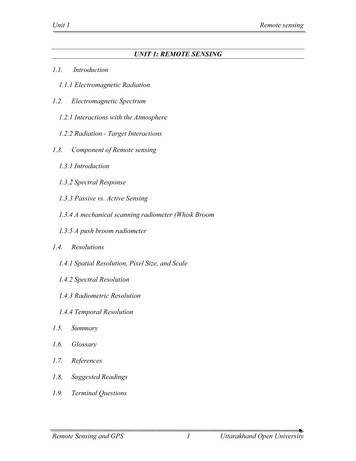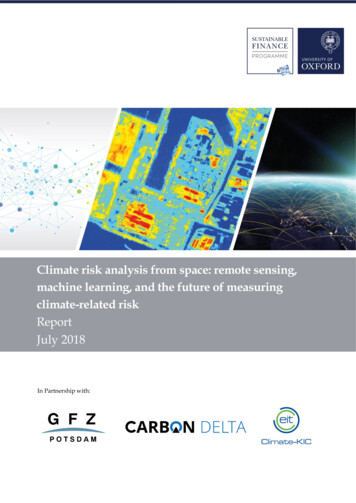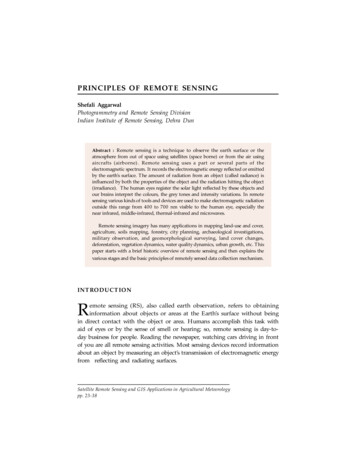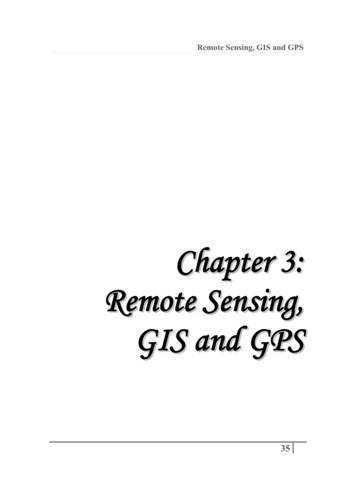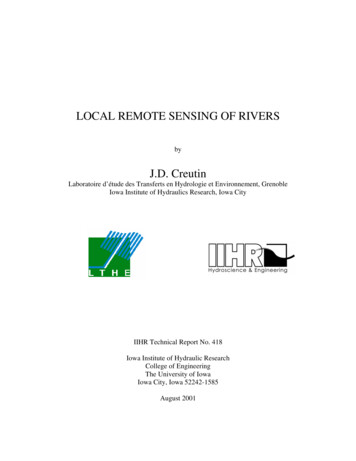
Transcription
LOCAL REMOTE SENSING OF RIVERSbyJ.D. CreutinLaboratoire d’étude des Transferts en Hydrologie et Environnement, GrenobleIowa Institute of Hydraulics Research, Iowa CityIIHR Technical Report No. 418Iowa Institute of Hydraulic ResearchCollege of EngineeringThe University of IowaIowa City, Iowa 52242-1585August 2001
TABLE OF CONTENTSOBJECTIVE, CONTENT AND CONCLUSIONS.1MOTIVATION OF THE REPORT .2THE RIVER MONITORING PROBLEM.3Variety of River Sizes and Shapes .3Geometry of the “valley” and of the gauged section .3Stability of the river bed.4Variability of the river in time.4Variety of Questions Posed .4Improving traditional gauging stations.4Modifying traditional practices .5LOCAL REMOTE SENSING OF RIVER SURFACE VELOCITY.5Visible and IR Imagery .5PIV method .5Advantages and drawbacks of the video imagery .6Doppler Radar .6Electromagnetic detection of water surfaces.7Conventional mono-static radar .9Bi-static radar . 10Advantages and drawbacks of Doppler radar technology . 12LOCAL REMOTE SENSING OF BATHYMETRY. 12GPR . 12LIDAR. 14LOCAL REMOTE SENSING OF STAGE. 14KEY RESEARCH ISSUES. 14Waves and Roughness Structures at the River Surface. 14Inversion of the Data and Assimilation in Hydro-Dynamics Models . 14BIBLIOGRAPHY . 15APPENDICES. 161:HYDRO21 Committee . 162:Proof-of-concept experiments to date . 163:Conventional river monitoring methods. 19i
Water velocity . 19Measurement of Water Levels . 21Dye dilution methods . 22Rating-curves. 224:Instruments and methods for aircraft and satellite remote sensing . 23Altimetry . 23SAR Imagers . 24Trajectory analysis . 255:Radar altimeters embarked on satellites . 266:Visit to USGS Water Resources Division in Menlo Park (California) . 267:Visit to CODAR Company in Palo Alto (California). 278:Visit to the Applied Physics Laboratory of the University ofWashington (Washington). 279:Question on river waves to RiverList members . 2810 :Some research teams and projects. 3011 :Some manufacturers and engineering companies . 3112:USGS Documentation on river discharge measurement . 3213:Illinois USGS Documentation on ADCP . 3214 :General considerations about wind waves . 33ii
LIST OF FIGURESFigurePage1Classification of river channel types and controlling variables after Mollard.32Apparent velocities identified by the PIV method in the Iowa River.53Bi-static radar SeaSond e by Codar in operation on a beach.74L-band radar return from a wave tank as a function of the frequency.85L-band radar returns from sea surface . 96Sketch showing the mono-static radar protocol chosen for rivers. 107Sketch illustration of the bi-static configuration. 118HF-radar return from ocean surface according to Barrick et al. 1974 . 119Installation of a GPR under a helicopter during the Cowlitz Riverexperiment in May 2001-08-24 . 1210GPR raw image of a Skagit River section according to Haeni et al. 2000 . 1311Cowlitz River Experiment on May 1, 2001-08-24 . 1912SonTek ADCP probe with converging beams on the bank of theCowlitz River on the 1st of May 2001. 20iii
OBJECTIVE, CONTENT AND CONCLUSIONSThis report aims at giving a synthetic view of developing local (i.e. not from space) non-contact(i.e. not direct) measurement of river discharges.This report considers the measurement of hydraulic parameters in river channels. It ignores themonitoring of water quality related parameters like temperature or pH as well as the questionsrelated to the presence of ice. A first section lists the variety of situations and the variety ofobjectives encountered in river monitoring. Even if it is well known, this diversity is good torecall since it constitutes a true specificity of hydrology compared to atmospheric or oceansciences where more homogeneous media simplify exploration strategies. The two followingsections are devoted to the core of the subject: the local remote sensing techniques used to datefor the measurement of river surface velocities and river depths. Basically, most of the reportedattempts concern the light/IR and the microwave/HF parts of the electro-magnetic spectrum andnot at all sound technologies. Regarding surface velocities, the alternatives are visible or IRimagery and Doppler radar. Regarding water depth, radar technology seems preferred to LIDARwhen this measurement is needed (unstable river bed). The last section addresses briefly somekey research issues. The report is completed with a reference section and appendices regardingcurrent research efforts in the area, a brief review of conventional river measurement methodsand satellite remote sensing of rivers and a summary of my last year activity on the topic.Following this study, I share the conclusion of the USGS/HYDRO21 Committee that non-contactmethods are the river gauging techniques of the future. In effect, it seems obvious that theknowledge of rivers can greatly benefit from remote sensing technologies such as those used forinvestigation of oceans or atmosphere. We are at a very exciting moment for this field ofinvestigation. Some keen pioneers are proud to show the real potential of different methodsthrough carefully selected examples. However, the problem is very complex and will certainlyrequire patience and efforts to be solved. I would like to provide herein some complementaryconclusions and recommendations.Due to their indirect nature and potential to revolutionise current practices, remote sensingtechniques are always difficult to implement. Indirect nature calls for a strict control of themultiple sources of uncertainties. Innovative capabilities call for a good capacity to renew theway the problems are posed. To my opinion, the techniques explored to date are still closelyinspired by the current in-situ practice. For instance the debate between point and bulkmeasurement is not yet considered.Due to the variety of situations and objectives in river monitoring, the above statement will beeven more true. Depending on the geology and the climate, rivers exhibit a tremendous variabilityof shapes and behaviours over a wide range of spatial and temporal scales. From simple waterbalance considerations to more complex ecological considerations, the objectives of rivermonitoring evolve and dictate new measurement requirements. From this respect, the localremote sensing solution for rivers will be diverse.As for all remote sensing projects, two conditions need to be fulfilled for the success of thisdomain:1) Constitution of a research community grouping applied physicists, hydrologists and fluidmechanicians. The successful use of sophisticated sensors relies on a good understanding of1
their physics and of the physics of the measured phenomenon. The constitution of such acommunity takes time and needs support.2) Early implication of practitioners of river management and of technologic developmentcompanies. Sensors need to be tailored and tested according to specific needs.MOTIVATION OF THE REPORTThe river discharge is the single parameter traditionally measured as a bulk indicator of riverdynamics. The discharge measurement method used today little evolved since the XIXth. century.It relies on the concept of stage-discharge relationship. The stage-discharge relationship (orrating-curve) assumes a univocal link between the level of the water in the river and thedischarge. The discharges are measured occasionally by exploring the stream velocity field with acurrent-meter in a cross section of the river. This manipulation is called river gauging. The stagesare measured on a continuous basis with a stage-meter or limnimeter. The stage-dischargerelationship is used to derive continuous series of discharges from continuous series of stages.This method applied to networks of thousands of stations across the world provided muchvaluable data with respect to their accuracy and homogeneity. The accuracy first stems from thegood validity of the rating curve concept which appears to be valid when the gauging section iswell chosen, i.e. with a stable and simple geometry. The accuracy is also due to the measurementprinciples used – the sensors are simple and in the river (direct measurements). The sensors usedlittle evolved in time, which explains the homogeneity of the data in time and space. This classictechnology is considered as indispensable for perennial series of data and as a reference for anykind of new device.Nevertheless, the hazards and costs related to this measurement technique of river discharge andon the other hand the evolution of the questions posed about rivers, lead to ask the question of themodernisation of river monitoring methods.The hazards essentially relate to high water periods. During floods, floating objects and waterturbulence make all type of direct measurement of the stream velocity extremely risky for theinstruments but also for the involved technical staff. In reason of this risk and also of thedifficulty to have staff present along the river during the flooding (specially in case of flashfloods), only 20% of the French rivers are gauged for discharge values exceeding the 10 yearreturn period.The costs are related to the gauging station itself which must be stable enough to endure floods(the Paillon river at Nice, 800km2, demolished three times its gauging station since 1942). Thecosts are also due to the need to have teams present along rivers at a priori unexpected times, witha non negligible possibility of simultaneous high waters on different rivers over a region. Thesecosts push the organisation in charge of river monitoring to reduce the number of gauging stationsand they make impossible the installation of ephemeral stations for purposes of research orspecific studies.The questions posed about rivers call either a diversification of the measurement types or densernetworks. The solid transport and water quality related issues, as well as the aquatic lifeconditions call for a detailed knowledge of the water velocity field. The validation of numericalmodels of river stream-flow necessitates more parameters than the global discharge. The detailedknowledge of rain distribution in space and time that is now available from weather radar2
detection, suggests that denser river monitoring networks would help the prediction of stormfloods. The monitoring of pollution shocks also needs denser river monitoring networks.Thus, it appears that the measurement of river flow needs to be modernised and complemented.This is well perceived by the organisation in charge of river monitoring in the United States (Seefor instance the activity of the HYDRO21 Committee of the USGS in Appendix 10) as well as bythe National Electricity Board in France (Personal communication of C. Lallement, 2001 fromEDF).THE RIVER MONITORING PROBLEMThe question of river monitoring is complex basically because of the wide variety of river sizesand shapes, from small upstream rills to estuaries, and because of the wide variety of questionsposed, from the traditional sizing of hydraulic works to more recent concerns about river ecology.The following lines do not pretend to give an exhaustive view of the problem. They simply list inan almost random manner a series of items reflecting the above mention complexity of theproblem. They try to figure out the changes one could expect moving from traditional to noncontact gauging techniques.Variety of River Sizes and ShapesRivers are verydiverse in spacedepending on thelevel consideredfrom upstreamrillstothedownstreamestuariesanddepending on thetypeofinteractionbetweentheclimate and thegeology controlsthe river. TheFigure1,extracted fromthe Handbook ofFigure 1: Classification of river channel types and controlling variablesHydrology p.8.7after Mollard.illustratestheverydifferentshapes rivers present according to major features such as sediment characteristics andtopography.As far as discharge measurement is concerned the most important factors are probably thefollowing:3
Geometry of the “valley” and of the gauged sectionThe geometry of the gauged section is of primary importance respect to the validity of the ratingcurve. The plausibility of a univocal relationship between level and discharge is higher when thegauged section has a simple hydraulic behaviour. This is why gauging sites have to avoidcomplex geometry such as pronounced meanders, breaded channels, marked sills etc Theaccessibility constrain frequently leads to establish gauging sections at bridge level which are notalways free of undesirable effects on the flow. Non-contact methods can alleviate this type ofconstrain, making the choice of a gauging section more focussed on the river section than onaccessibility.The geometry of the valley itself enters into play again with the accessibility question. In deepmountainous valleys, the only convenient access to rivers is given by bridges. Non contactmethods should substantially change this constrain.Stability of the river bedThe stability of the river bed is a second important validity condition for the rating curve. Againthe advantage of remote-sensing methods could be to allow gauging in places with pooraccessibility but better bed stability (search for natural sills stabilising the river bed for instance).Variability of the river in timeRivers are also diverse in time according to climate fluctuations. In quickly varying rivers, one ofthe most constraining aspects of gauging is to perform the entire measurement at a constant levelor discharge. This is true for all type of flow but specially for high flows. The drastic reduction ofthe gauging time provided by remote-sensing should completely change this point. Even in aquickly rising or descending river one can reasonably expect from non-contact methods thecapability to continuously gauge and thus to change this adverse situation for traditional methodsinto a favourable one to rapidly explore a large portion of the rating-curve.Variety of Questions PosedWhen new monitoring techniques appear, it is always difficult to figure out the way they willmodify the questions traditionally posed.At present, the way river monitoring is organised is deeply marked by the gauging methodology.The only variable which is routinely monitored is the level, setting the gauging station andestablishing the rating-curve represents a considerable investment. The consequence is that theflexibility of the gauging networks is very weak (moving stations is almost impossible) and thatpossibilities like i) temporary densification of the gauging network for a specific study or ii)redeployment of an existing network according to new management objectives appear to beunfeasible.The use of remote sensing techniques for river survey can be seen either as a way to improvetraditional gauging techniques or as a way to change this traditional practice.Improving traditional gauging stationsFor practical reasons of continuity and reliability of the produced data, the non-contact methodsmust be used in complement of contact methods. They can provide the following improvementsat sites already equipped with a gauging station:- continuous monitoring of the surface velocity field needed for a better management of waterquality problems,4
-reduction of the cost and risk associated to the identification of the rating curve,design of a new non-contact station finding the appropriate combination of measurement ableto provide at least a comparable accuracy.Modifying traditional practicesThe deep motivation for changing the present practice would definitely be to go from the conceptof precise point control to the concept of space distributed runoff monitoring. The question is thento find a new compromise between costs, accuracy of measurement and spatial density ofmeasurements. These aspects still certainly belong to the research domain.LOCAL REMOTE SENSING OF RIVER SURFACE VELOCITYEssentially two non-contact methods have been tested to measure the water velocity at the riversurface. The first relies on the digital images in visible or infrared (IR) that can be taken usingvideo or picture cameras. It can be considered as a passive detection methods since the naturalemission of the river surface is used. The second relies on radar detection using wavelengths frommicrowaves to radio waves. It is an active detection method. Other methods could be based onLIDAR or SODAR techniques – they have not been experimented.In any case it can be noted that the identified velocity is a “surface” velocity that needs to beextended to the vertical profile in order to produce a discharge measurement. This extension canbe done in a simple manner like in classical gauging techniques where the profile is assumed tohave a given shape (power law in general). It can also be done in a more comprehensive way byassimilation to a flow model (see for instance Sulzer et al., 2000 or Bradley et al., 2001).The access to the 3D velocity field using a non-contact method seems to be out of reach for theexisting technology.Visible and IR ImageryPIV methodFigure 2: Apparent velocities identified by the PIV methodin the Iowa River (IIHR document).5In experimental fluid mechanics,the use of images to measurefluid particle velocity is a wellestablished technique known asParticle Image Velocimetry(PIV). Different books describethe theory and application of thePIV method (see for instanceRaffel et al., 1998). The principleof measurement is to use avisible light video camera (asopposed to IR video camera)withappropriatelightingconditions in order to imagenatural tracers present in thewater at two successive instantsand then to process these imagesinordertoderivethe
displacement of the tracers. The processing essentially includes two steps: i) the geometricaltransformation allowing to go from the picture plan to the physical plan and ii) the correlationanalysis allowing to identify the tracers displacement. At the early stage of the method, the twosuccessive instants were recorded on the same image thanks to successive light flash during thesame camera aperture. The improvement of film cameras and the arrival of video cameras led tothe use of two distinct images, which simplifies and improves the correlation analysis. Thelighting improvement thanks to laser sources also dramatically refined the possibilities of themethod.In rivers, the application of the PIV method is still limited to i) some pilot experiments (on theIowa River on March 97 as shown on the Figure 2 and latter in Bradley et al., 2001) and ii) somepilot applications (different river gauging stations equipped with video cameras in Japan – M.Muste, personal communication).Advantages and drawbacks of the video imageryThe advantages of the method:- The low cost and the transportability of the sensor. Digital cameras (picture or video) are ofthe order of 1000 cost units ( or ) and easy to plug to portable microcomputers. Theensemble can be easily moved and installed.- The apparent simplicity of the principle. The optics of a camera is pretty simple to model andthus the issues related to image geometry are probably simple to solve. The interactionbetween the light source (natural or artificial) and the river surface that gives the detectedvalues is probably less simple to understand.- The possibility to analyse visually the pictures before processing allows a better identificationof the state of the river (type of flow, type of available targets ).- The retrieval of the detailed 2D velocity field (no assumption is made about the main flowdirection compared to “active” methods).The drawbacks of the method:- The need of light (day light – passive detection or artificial light – active detection) and theneed of clear air at the river surface (absence of fog or any type of water emulsion due to theturbulence of the river flow and diffracting light) are certainly crucial limitations of themethod in rugged conditions.- The need of “tracers” is also a serious issue. Artificial seeding using “environmental friendly”tracers can be a solution but in some sense sticks the method to contact methods. Non-seededPIV deserve more attention in two senses: i) depending on river conditions and the scale ofinterest, many “structures” advected by the river current can serve as tracers (fluid turbulencestructure, wind waves, floating bodies), and ii) time integration can help in having areasonable description of the surface velocity speed with low density of natural tracers.- The data processing is not yet clearly formalised and many questions remain pending. In spiteit is intuitively easy to understand the cross-correlation method and in spite it is used in manydifferent fields, I did not find the exact meaning of the optimisation achieved by this method.The method looks for a maximal coefficient of correlation that corresponds to maximising theexplained variance of one image by the other – the link with the “optimality” of the deriveddisplacement is not obvious.Doppler RadarThe most popular examples of radar detection of water bodies come from the use of SyntheticAperture Radar (SAR) and Radar Altimeters on satellites. They concern both non-Doppler radarsystems. They are both very well described in different books on remote sensing (see for instanceUlaby et al., 1986). They are briefly reviewed in Appendix 4.6
The Doppler capability of measuring radial velocities of targets has been used over oceans in theperspective of measuring currents (Barrick et al., 1974 for UHF, Plant and Keller, 1990 formicrowaves). At present two antenna configurations used for ocean currents have been adaptedand tested on rivers. In the following we recall some basic principles on the electromagneticdetection of water surfaces and we describe the mono-static and bi-static configurations tested inrivers (see illustration in Figure 3).Electromagnetic detection of water surfacesOnly periodic waves have been the object of a clearanalysis in terms of radar detection. This analysisrelies on the so-called Bragg scattering effect byanalogy with the X-ray resonance in minerals. Itapplies well to wind generated waves over large bodiesof water like seas or lakes. According to the Braggtheory, a periodic surface with a wavelength Λ (capitalletter for water related variables) is known to reflectEM waves of length λ (the radar wavelength, denotedwith a low-case letter) if the following relationship issatisfied:λ 2Λ cos Φwhere Φ is the grazing angle (i.e. the angle betweenthe EM wave propagation line and the water surface)Figure 3: Bi-static radar SeaSonde and provided the surface is slightly rough (slopes 1,by Codar in operation on a beach.height of the water waves Λ). Given a radarwavelength and a grazing angle, only one waterwavelength can be distinguished by a radar according to the Bragg theory.This relationship means that for the typically used frequencies (microwaves in X-band and overto LF waves) the following water wavelengths (in cm) are detected:Φ10 GHz λradar 3cm300 MHz λradar 1m10 X1.52UHF 51.030 1.7358.045 2.1271.060 3.0100.0Note that the concerned waves are essentially gravity waves (the theoretical wavelength limitbetween capillary and gravity waves being around 1.7cm). Such waves appear to be verycommon on sea surfaces exposed to wind (see Appendix 15 for elementary considerations onwind generation of waves).7
If the radar is able to measure the frequencyspectrum of the return signal (Doppler orcoherent radar), the frequency differencebetween the transmitted and the received signalwill indicate the apparent velocity of thedetected water wave family in the direction ofthe propagation of the radar signal (antennaaxis for a classic parabolic antenna). The shift F will satisfy the following relationship: F VA/ΛcosΦFigure 4: L-band radar return from a wavetank as a function of the frequency.The question is then to establish what is thisapparent wave velocity VA. It reflects in factboth the phase velocity VP of the waves andtheir group velocity VG that depends on thewind advection and on the underlying current.The frequency shift can thus be reformulated as: F (VP VG)/ΛcosΦ.For a radar wavelength and grazing angle, the targeted wave family in the direction of the radarsignal propagation comprises advancing and recessing waves that are assumed to propagate inopposite directions at their theoretical phase velocity. In absence of group velocity, these wavesgive two signal peaks at symmetric frequency shifts: F /-VP/ΛcosΦThe group velocity acting in the same direction on the processing and the recessing waves willshift the two symmetric peaks the same way, leading to a signal spectrum which is no moresymmetrical respect to 0 as on Figure 4 extracted from Plant and Keller,1990. At L-band(λ 16cm) and for the chosen grazing angle Φ 36 , the targeted waves have a wavelength ofΛ 6.47cm. Note that the advancing wave peak (positive shift of 8Hz) provides a stronger returnsince it corresponds to more developed waves. Note also that the shift due to the group velocity isof about 1Hz in the same direction as the processing waves and that the phase velocity is of about7Hz. This shift corresponds to a phase velocity VP 90cm.s-1 close to the expected theoreticalphase velocity. The 1Hz shift corresponds to a 13cm.s-1 group velocity that is to be connected tothe 20cm.s-1 wind imposed at the surface.In natural conditions, the received echoes are naturally more complex than from controlledexperiments. See for instance the Figure 5 corresponding to sea echoes at C-band (Plant andKeller, 1990) obtained with a wind direction almost perpendicular to the antenna axis and acurrent of ca 60cm.s-1. Among the possible reasons for the wider dispersion of the receivedspectrum, one can put forward the following ones:- The
LOCAL REMOTE SENSING OF RIVERS by J.D. Creutin Laboratoire d'étude des Transferts en Hydrologie et Environnement, Grenoble Iowa Institute of Hydraulics Research, Iowa City IIHR Technical Report No. 418 Iowa Institute of Hydraulic Research College of Engineering The University of Iowa Iowa City, Iowa 52242-1585 August 2001
